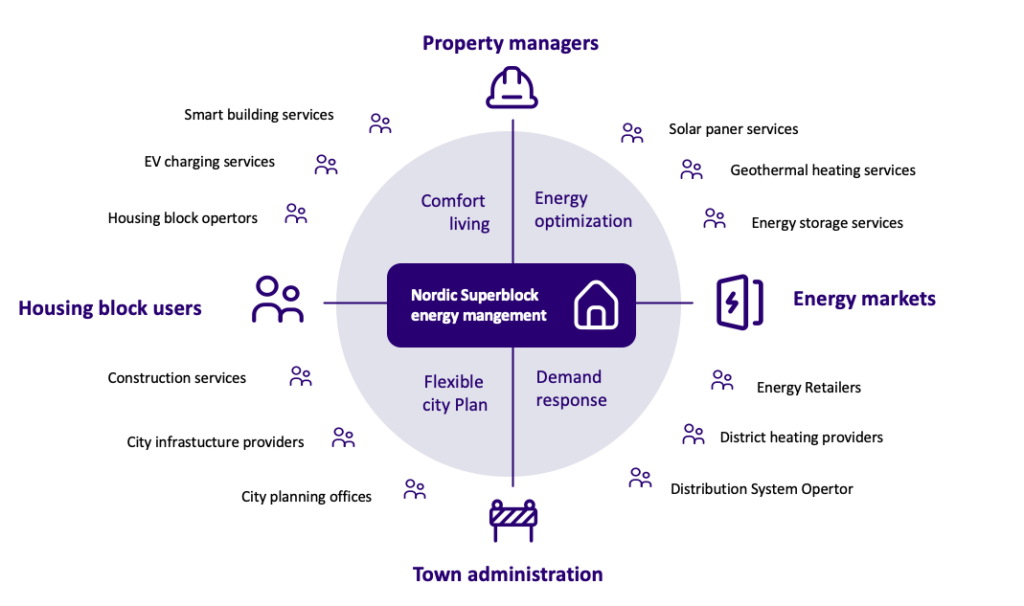Decide how much to pay for your energy
If property owners, managers, and users don’t want to be dictated their energy price, the only way to affect the price is putting data to smarter use and forming energy communities that enable joint investment to provide benefits for every one of its members. Below are some pointers.
Energy prices are one of today’s major headaches for everyone from private households to national governments.
The European Union intends to achieve climate neutrality by 2050, but some countries, such as Finland, are even more ambitious. Finland wants to reach carbon neutrality by the year 2035.
Carbon neutrality means emission-free power generation, which means renewable energy. Renewable energy sources are dependent on weather. You get more power if it’s windy or sunny, but much less if there’s no wind or it’s cloudy.
At the same time, society is electrifying at an accelerating rate. More and more of what used to be powered by something else is becoming powered by electricity.
We are therefore faced with a serious dilemma. More energy is needed by the year, but at the same time, more of what can be generated is dependent on uncontrollable conditions.
What can we do?
Energy users must take the initiative
To put it bluntly, there is no way to increase fluctuating renewables-based power generation at a pace that keeps up with steadily increasing demand.
That is why energy users, such as property owners and managers, as well as town administrations, need to find ways of managing their energy consumption in ways that reduce the need for energy while not hampering operations and increasing the price they have to pay. Therefore, energy users need to accept more responsibility.
Basically, they have two options. One, hedge against adverse market swings by entering fixed-price contracts. Two, find smarter, data-based ways of reacting to energy price fluctuations.
Data is the key, but seriously underused
Properties produce large amounts of operational data, but the data is usually dispersed between many systems of varying age. This means that the properties are unable to communicate with external systems or offer a consolidated operational view.
The problem is compounded by the fact that individual residential properties have not been commercially interesting from the point of view of a wider regional energy system.
This situation, though, is rapidly changing. Increasing energy capacity is rapidly emerging in almost all properties. The batteries of electric vehicles are connected to the power system, there are more and more solar panels on the roofs, geothermal heating plants are becoming more popular, and rooms are heated with smart heat pumps capable of reacting to changes in the energy system they are connected to.

Picture: Actors and solutions are needed that enable property owners and operators to come together for smarter energy management
Energy users of the world, unite
As in so many other aspects of life, uniting into larger entities is beneficial. Actors and solutions are needed that enable property owners and operators to come together regionally to coordinate their micro-generation, storage, and consumption optimization. In such an environment, investment in a joint geothermal heating plant, or a solar farm with storage capabilities begins to look quite different from the viewpoint of one property.
Key to making all this work is data management that enables efficient control and steering of the operation to benefit all participants in an equal and fair manner.
Economies of scale to push down prices
The Nordic Superblocks as Decarbonization Catalysts (NSDC) initiative, sponsored by Business Finland through NextGeneration EU funding, aims at turning these ambitions into reality.
With members including Tampere University, Skanska, Granlund, Integrio, Kone, and Synocus, the NSDC initiative researches and develops operational models for residential properties. The aim is to enable property users to have more leverage in how their properties use energy, how much they pay for it, and how it affects living comfort.
The Nordic Superblocks concept supports the participating cities with concrete piloting activities that they need to speed up their decarbonization efforts in an innovative, cost-effective, and community-oriented way.
Tietoevry’s role is to develop software solutions for the management of energy data and demand response, as well as ways to utilize them in property energy management.
Get in touch to save
If your job involves property energy management, we would be delighted to hear from you. Read more about the NSDC initiative and get in touch with Antti Seppälä. Let’s work out a solution that rationalizes your energy management.
For more information contact
Antti Seppälä, Tietoevry, antti.seppala@tietoevry.com
Jussi Hulkkonen, Synocus, jussi.hulkkonen@synocus.com